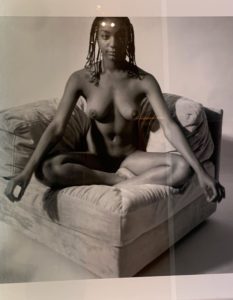Curated by Dr. Gannit Ankori, the Henry and Lois Foster director and chief curator of the Rose Art Museum at Brandeis University, and guest curator of African and African Diaspora art, Dr. Elyan J. Hill, this exhibition focuses on displaying the multifaceted nature of Barkley L. Hendricks’ art. Beginning on February 10th, 2022, and ending on July 24th, 2022, if you’re looking for a weekend trip or an excuse to impress your date with your taste in artistry, this is where you need to be. Showcasing photography, painting, and much more, Hendricks addresses different themes and questions about gender, race, sexuality, and visibility. Through this exhibition, we work with these mediums to better understand both him as an artist, the period he created in, and how both shaped and displayed his personhood.
It is broken up into five sections: The Eye and the Lens – Reflections of Self; My People, Fashion and Desire; Boombox + Television; and I, too, Sing America. When I went to see it, I was mesmerized by the vibrant color and the way everyday people were represented in his paintings and photographs. I looked further into the curation process for this exhibition, and I realized, first, how intentional Hendricks’ art process was and, second, the fact that I wasn’t applying enough complexity to the work I was experiencing. The idea of creating visibility by capturing life through the camera lens is introduced beginning with the title, “My Mechanical Sketchbook.” This helped me also recognize the attention to detail when it came to his paintings, and how this, too, served as a replica of a photograph. Acknowledging this idea gives way to the understanding of intimacy within every section of this ‘sketchbook,’ through the display of nakedness within the physical, emotional, and psychological as well as their relationship to ideas of desire, freedom, safety, harm, and comfort.
I felt like nakedness served as a motif in every section of the exhibition. First, involving the body, we see the exposure of ‘private parts’ in plain view, challenging what is considered safe to display in relation to the physical. This atmosphere was shown in works like “Untitled,” a piece consisting of the artist in a Superman T-shirt, “Self Portrait,” and “Vendetta in Lotus Position.” Transitioning into the emotional realm, the idea of nakedness melds with the expression of joy throughout these pieces, with instances where Black people were showcased smiling, dancing, and taking up center stage and space (“Passion Dancehall #1” and “John Wayne”). To me, it felt like releasing what is forced into confinement–not solely as a result of the oppressive nature of our society concerning our race, but also in response to the general idea that Black people cannot curate a culture of happiness without it being associated with the political, or struggle, or both.
It made me sit with the fact that although Black people still occupy areas within resistance, our joy is not mutually exclusive to our search for freedom.
There were also different moments where I noticed the idea of nakedness in the psychological realm. This was a period where Hendricks commented on the idea of visibility when it is not in our control. With the inclusion of Professor Anita Hill during the moment of her testimony, the depiction of Black boys and men and the violence they experience as a result of surveillance, and the exposure of bigotry and hatred within America, I was moved by the way he recognized each instant where the lives of Black people were thrust onto the world stage without our consent and without regard for our humanity.
There is a reason for why Hendricks presented many different versions of himself within his art media. In a society where we have to fight for both attention as well as privacy from the public eye, I felt like he was also conveying how necessary it was for the public to accurately depict his Blackness in a way where he was a part of every bit of the process. This kind of agency was inspiring; it left me in deep thought and also pain. I guess the painful part had to do with my mourning for all the people who look like and came before me and suffered as a result of this kind of surveillance. But toward the end, I became inspired to be a part of the resistance that does not allow for this kind of violence to continue. 
To end, note that I did not refer to Hendricks as a political artist. This is in observance of his own need to ensure the world did not place him in this box. I think it’s important to emphasize this part for all of you going to this exhibition to free up your mindspace and allow yourself to approach his art with more complexity than the “political artist” label would allow. The ability to challenge restrictive understandings of gender, desire, freedom, and nakedness requires an attention to detail and just simply being able to live.
There is so much I didn’t even touch on, like his artistic commentary on fashion and its relationship to all people as well as to Blackness. His love for music and how this existed during times like the 80s. And lastly his love for poets like Langston Hughes, and how his poetry actually shaped part of the curation process for both Dr. Ankori and Dr. Hill. However, I can’t fit everything into this piece; you’ll have to go and see for yourself. Take a break and go sit with an artist who just might change how you view the world.


